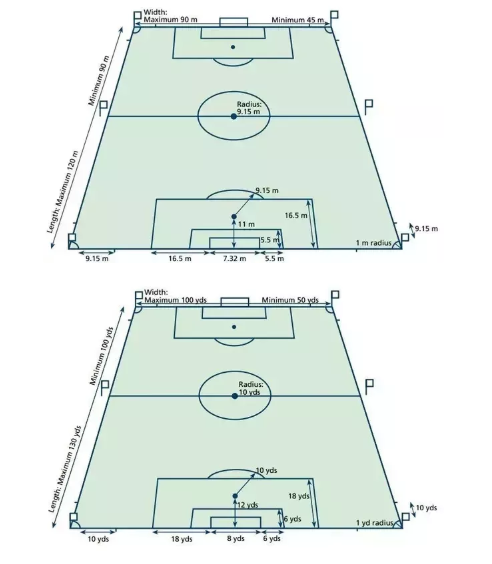Soccer Field Dimensions In Feet
Soccer Field Dimensions In Feet
Soccer Field: Soccer, formally known as association football, is the world’s most popular team sports that features opposing two teams of 11 players, playing on a wide rectangular grassy field, with a spherical ball being played until it touches a netted area called the goal. The objective of the game is to score by putting the spherical ball inside the opposite team’s goal. The team that scores most goals wins the game. If the score between both teams is leveled, it is declared a draw, or extra minutes will be provided to continue playing or do penalty shootout to determine the winner, depending on the format of the game they played.
This sport is one of those games that is not allowed to used hands in playing. Goalkeepers, those players that are positioned at the entrance of the netted area, are an exception to that rule as they are the only player allowed to use hands in playing the soccer ball during play and only in their penalty area.

Soccer Field
The soccer-specific stadium is a term used mainly in the United States and Canada to refer to a sports stadium either purpose-built or fundamentally redesigned for soccer and whose primary function is to host soccer matches, as opposed to a multipurpose stadium which is for a variety of sports. A soccer-specific stadium may host other sporting events (such as lacrosse, American football, and rugby) and concerts, but the design and purpose of a soccer-specific stadium are primarily for soccer. Some facilities (for example Toyota Park, Toyota Stadium and Mapfre Stadium) have a permanent stage at one end of the stadium used for staging concerts.
A soccer-specific stadium typically has amenities, dimensions, and scale suitable for soccer in North America, including a scoreboard, video screen, luxury suites and possibly a roof. The field dimensions are within the range found optimal by FIFA: 110–120 yards (100–110 m) long by 70–80 yards (64–73 m) wide. These soccer field dimensions are wider than the regulation American football field width of 53 1⁄3 yards (48.8 m), or the 65-yard (59 m) width of a Canadian football field. The playing surface typically consists of grass as opposed to artificial turf, as the latter is generally disfavored for soccer matches since players are more susceptible to injuries. However, some soccer-specific stadiums, such as Portland’s Providence Park and Creighton University’s Morrison Stadium, do have artificial turf.
The seating capacity is generally small enough to provide an intimate setting, between 18,000 and 30,000 for a Major League Soccer franchise, or smaller for college or minor league soccer teams. This is in comparison to the much larger American football stadiums that mostly range between 60,000 and 80,000 in which the original North American Soccer League teams played and most MLS teams occupied during the league’s inception. As opposed to gridiron-style football stadiums, where the front row of seats is elevated several feet above the field of play to allow spectators to see over the heads of substitute players and coaches on the sidelines, soccer-specific venues typically have the front row closer to the level of the pitch, providing a more intimate experience.
Soccer Field Dimensions
The soccer field, or football pitch, is flexible in size. It is 100 to 130 yards (90-120m) long and 50 to 100 yards (45-90m) wide. In international play, the field dimensions are a bit stricter in that the length must be 110 to 120 yards (100 – 110m) long and 70 to 80 yards (64 – 75m) wide.
The dimensions of the soccer field are specified in Law 1 of the FIFA Official Laws of the Game. Soccer is one of the games that have rules written and codified into law. FIFA (Fédération Internationale de Football Association or International Federation of Association Football in English) is the international governing body for association football, futsal and beach soccer. The organization is responsible for the administration of major football tournaments such as the World Cup, oversees 209 member nations and in-charge of promotions through tournaments at which they gather their revenue. Although FIFA is the governing body, they do not have total control about the rulings of the game, although they are in charge of maintaining the Laws of the Game
Soccer Field Diagram

How Big Is A Soccer Field
The soccer field has a centerline that stretches across the center to separate the attacking and defending zones. The center circle is marked from the center spot of the field in a 10 yard (9.15 meter) radius.

On either end of the soccer field, the penalty area is a rectangle area marked off in front of each goal. The penalty area is measured 18 yards (15.5 meters) from the goal line and extends 18 yards beyond each goal post creating an area approximately 18 yards X 44 yards assuming the use of an 8-yard goal.
The goal area is also marked off in front of each goal. The goal area is measured 6 yards (5.5 meters) from the goal line and 6 yards beyond each goal post creating an area approximately 6 yards X 20 yards.
The soccer field diagram below will show you the measurements of a standard pitch. Remember that not all soccer fields are the same size and will vary depending on the age and number of players playing in the match. For players under 12 years of age, a smaller soccer field is recommended.
The soccer field, or football pitch, is flexible in size. It is 100 to 130 yards (90-120m) long and 50 to 100 yards (45-90m) wide. In the international play, the field dimensions are a bit stricter in that the length must be 110 to 120 yards (100 – 110m) long and 70 to 80 yards (64 – 75m) wide.
How Long Is A Soccer Field
The soccer field, or football pitch, is flexible in size. It is 100 to 130 yards (90-120m) long and 50 to 100 yards (45-90m) wide. In international play, the field dimensions are a bit stricter in that the length must be 110 to 120 yards (100 – 110m) long and 70 to 80 yards (64 – 75m) wide.
An additional rule is that the length has to be longer than the width, so you couldn’t have a square field of 100 yards by 100 yards.
Even though these are the official rules, many kid’s soccer games are played on even smaller fields than the minimum. Although the length and width are flexible, other areas of the field are generally fixed in size.
The Goal
At each end of the field is the goal. The goal is 8 yards wide and 8 feet high and is placed at the center of the goal line. They have nets to catch the ball so you don’t have to chase it, plus it helps the referee to determine if a goal was scored.
The Boundary
The boundary of the field is drawn with lines. The lines on sides, or the long side of the field, are called the touchlines or sidelines. The lines at the end of the field are called the goal lines or end lines.
The Center
In the middle of the field is the centerline which cuts the field in half. At the very center of the field is the center circle. The center circle is 10 yards in diameter.
Soccer Field Size
The field dimensions and information are as follows:
The field of play must be rectangular and marked with lines. These lines belong to the areas of which they are boundaries.
The center mark is indicated at the midpoint of the halfway line. A circle with a radius of 9.15 m (10 yds) is marked around it.
Marks may be made off the field of play, 9.15 m (10 yds) from the corner arc and at right angles to the goal lines and the touchlines, to ensure that defending players retreat this distance when a corner kick is being taken.
All marking lines must be of the same width, which must be not more than 12 cm (5 in).
The entire playing field should be within the following dimensions:
Standard–> Touchline (length): 90 m (100 yd) to 120 m (130 yd); Goal line (width) : 45 m (50 yd) to 90 m (100 yd)
International matches –> Touchline (length): 100 m (110 yd) to 110 m (120 yd); Goal line (width) : 64 m (70 yd) to 75 m (80 yd)
Two lines are drawn at right angles to the goal line, 5.5 m (6 yds) from the inside of each goalpost. These lines extend into the field of play for a distance of 5.5 m (6 yds) and are joined by a line drawn a parallel with the goal line. The area bounded by these lines and the goal line is the goal area.
Two lines are drawn at right angles to the goal line, 16.5 m (18 yds) from the inside of each goalpost. These lines extend into the field of play for a distance of 16.5 m (18 yds) and are joined by a line drawn a parallel with the goal line. The area bounded by these lines and the goal line is the penalty area.
Within each penalty area, a penalty mark is made 11 m (12 yds) from the midpoint between the goalposts and equidistant to them.
An arc of a circle with a radius of 9.15 m (10 yds) from the center of each penalty mark is drawn outside the penalty area.
A quarter circle with a radius of 1 m (1 yd) from each corner flag post is drawn inside the field of play.
The distance between the posts of the goal is 7.32 m (8 yds) and the distance from the lower edge of the crossbar to the ground is 2.44 m (8 ft).
Indoor Soccer Field
Indoor soccer or arena soccer (known internationally as indoor football, mini football, fast football, floorball or snowball), is a game derived from association football adapted for play in a walled indoor arena. Indoor soccer, as it is most often known in the United States and Canada, was originally developed in these two countries as a way to play soccer during the winter months, when snow would make outdoor play difficult. In those countries, gymnasiums are adapted for indoor soccer play. In other countries, the game is played in either indoor or outdoor arenas surrounded by walls and is referred to by different names (such as fast football (futbol Rapido) in Mexico, showboat in South America, and indoor football (futbol indoor) in Spain).
Indoor soccer has different regulations from other versions of association football designed for indoor play, such as futsal and five-a-side football. Unlike futsal, which is played on wooden or ceramic surfaces, indoor soccer is played on synthetic turf (or, in the case of the British Masters Football variety, synthetic carpet).[1] Indoor soccer courts are delimited by walls instead of lines, and there are no player throw-ins.
FIFA, the international body that oversees international association football competitions, does not sanction the synthetic turf version of indoor soccer, having developed its own code of indoor football (which they refer to as futsal).
Indoor soccer is most popular in the United States, Canada, and Mexico, with several amateurs, collegiate and professional leagues functioning. While internationally less popular than futsal, indoor soccer is also played at the league level in many countries outside North America. The World Minifootball Federation (WMF) is the governing body of indoor soccer at the international level, having replaced the International Fast Football Federation (FIFRA).


